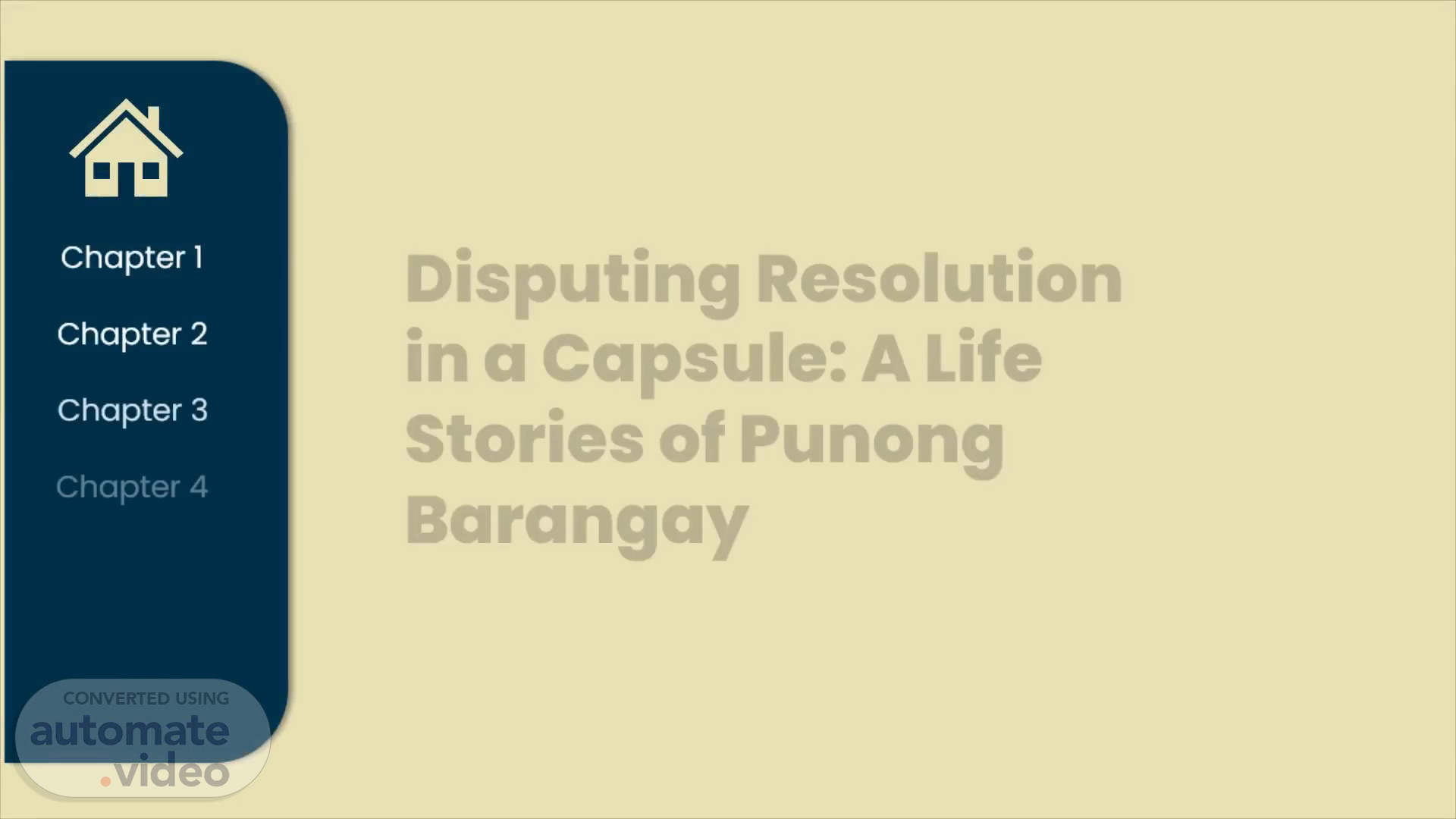
PowerPoint Presentation
Scene 1 (0s)
Chapter 1. Chapter 1. Chapter 2. Chapter 2. Chapter 3.
Scene 2 (22s)
INTRODUCTION. Background of the Study. Background of the Study.
Scene 3 (55s)
In this study, the techniques and strategies of the punong barangay will be shared and discovered for the benefit of the other punong barangay, as well as the peace and order in the community. This study will provide plans, ways and strategies in the dispute resolution of the punong barangay in Municipality of Hilongos , Leyte . In this way, it will reflect on how peaceful the barangays are. And how responsible the people in the community are living..
Scene 4 (1m 20s)
INTRODUCTION. 1. What are the challenges encountered by the Brgy . Captain in terms of resolving problems? 2.How the Brgy . Captain manages to resolve the dispute that occurs/occurred in the barangay? 3. What are the techniques/strategies that they applied/implemented in order to keep peace and order?.
Scene 5 (1m 39s)
THEORETICAL BACKGROUND. As cited by Adam Hayes (2020), “Conflict theory, first purported by Karl Marx, is a theory that society is in a state of perpetual conflict because of competition for limited resources. Conflict theory holds that social order is maintained by domination and power, rather than by consensus and conformity.” Conflict theory focuses on the competition between groups within society over limited resources. Some individuals and organizations can obtain and keep more resources than others, and these “winners'' use their power and influence to maintain social institutions. This is usually the source of conflict that occurs in every barangay that the Punong barangay needs to solve in order to keep peace and order.
Scene 6 (2m 10s)
THEORETICAL BACKGROUND. As stated by Pon Staff (2021) "Conflict resolution theory guides the informal or formal process that two or more parties use to find a peaceful solution to their dispute. Another aspect of conflict resolution theory includes bringing in the outside assistance of a mediator. In mediation, disputants enlist a trained, neutral third party to help them come to a consensus. Rather than imposing a solution, a professional mediator encourages disputants to explore the interests underlying their positions. Working with parties both together and separately, mediators seek to help them discover a resolution that is sustainable, voluntary, and nonbinding.".
Scene 7 (2m 38s)
Research Design. This study uses a qualitative method and utilizes experiential approach through the aid of interview questions wherein it focuses on the Dispute Resolution of the Punong Barangay. Experiential research requires a method which preserves the vitality of experience as it happens as well as provide the insights and meaning which are included. This study describes the experiences of the Barangay Captain regarding dispute resolution particularly on how to handle such disputes and also on the strategies and techniques applied to resolve certain disputes. In accordance with an in-depth interview, researchers will obtain better information that is useful to answer the questions provided in this study..
Scene 8 (3m 9s)
Research Environment. The Municipality of Hilongos is consist of 51 barangays and informants come from these 10 barangays namely: Marangog , Imelda, Eastern, Paa , Owak , Lamak , Tejero , Atabay , Bagong Lipunan, Concepcion. Hilongos is one of the municipalities in Leyte. Leyte has 40 municipalities and 2 cities and the total number of barangays in the province is 1503 with a total population of 399,13776, 847 in 2020. Officially the Municipality of Hilongos is a 4o th class Municipality in the province of Leyte, Philippines. According to the 2020 census, it has a population of 2,626,970 people with 1,782,788 households..
Scene 9 (3m 40s)
Research Informant. The research informant of this study is consist of 10 barangay captains of Hilongos , Leyte namely: Marangog , Imelda, Eastern, Paa , Owak , Lamak , Tejero , Atabay , Bagong Lipunan, Concepcion. barangay captain with a minimum experience of 1 year of service ..
Scene 10 (3m 58s)
ANAYSIS OF DATA. Chapter 1. Chapter 1. Chapter 2.
Scene 11 (4m 23s)
ANAYSIS OF DATA. Chapter 1. Chapter 1. Chapter 2.
Scene 12 (4m 53s)
ANAYSIS OF DATA. Chapter 1. Chapter 1. Chapter 2.
Scene 13 (5m 29s)
ANAYSIS OF DATA. Chapter 1. Chapter 1. Chapter 2.
Scene 14 (5m 46s)
ANAYSIS OF DATA. Chapter 1. Chapter 1. Chapter 2.
Scene 15 (6m 20s)
ANAYSIS OF DATA. Chapter 1. Chapter 1. Chapter 2.
Scene 16 (6m 49s)
ANAYSIS OF DATA. Chapter 1. Chapter 1. Chapter 2.
Scene 17 (7m 20s)
PRESENTATION OF EMERGENT T HEMES. Chapter 1. Chapter 1.
Scene 18 (7m 38s)
PRESENTATION OF EMERGENT T HEMES. Chapter 1. Chapter 1.
Scene 19 (7m 51s)
PRESENTATION OF EMERGENT T HEMES. Chapter 1. Chapter 1.
Scene 20 (8m 6s)
SUMMARY, FINDINGS, AND IMPLICATION. Summary. Summary.
Scene 21 (8m 32s)
House with solid fill. House with solid fill. Chapter 1.
Scene 22 (9m 1s)
SUMMARY, FINDINGS, AND IMPLICATION. Chapter 1. Chapter 1.
Scene 23 (9m 33s)
SUMMARY, FINDINGS, AND IMPLICATION. Chapter 1. Chapter 1.
Scene 24 (9m 53s)
House with solid fill. House with solid fill. Chapter 1.
Scene 25 (10m 16s)
House with solid fill. House with solid fill. Chapter 1.
Scene 26 (10m 35s)
END OF PRESENTATION THANK YOU!.